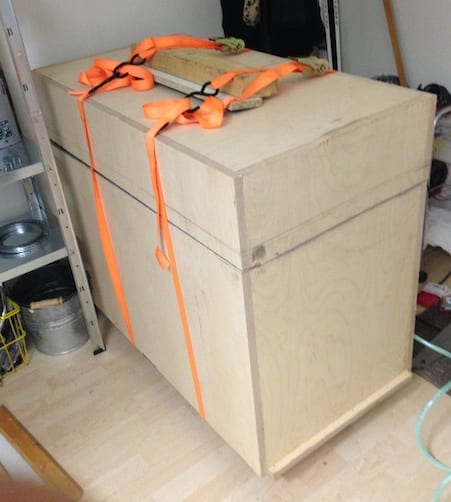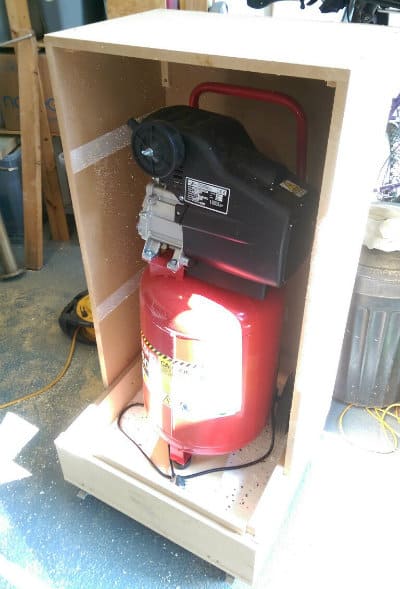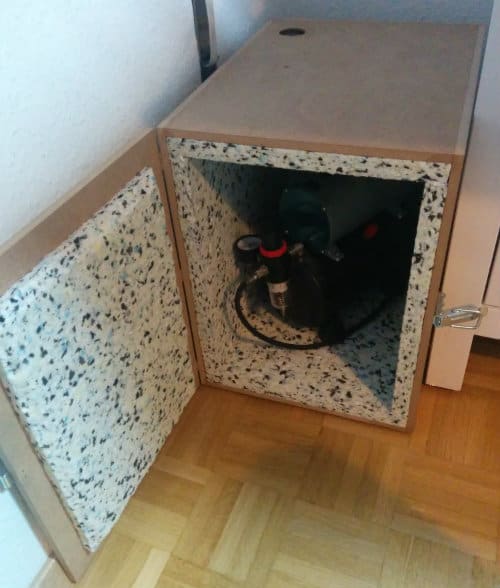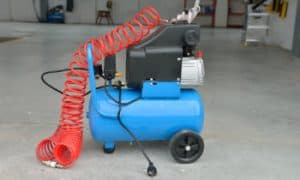I’ve found my air compressor to be an invaluable tool. It’s also as loud as a motorcycle, and my wife hates the constant noise on the weekends! Eventually, she told me I needed to build a soundproof box for air compressor.
It turns out, many people have this problem, and many solutions have been built. In my research, I came across 17 ideas that fit my needs and I want to share them with you. Before building the soundproof enclosure, however, there are a few things you’ll need to account for in the design.
Note: For other information on keeping power equipment quiet–including another box design–please see our article How to Make a Generator Quiet.
Things to Consider Before Building Air Compressor Enclosure
Imagine building your soundproof enclosure, but when you go to put the compressor inside it doesn’t fit! For this reason, the size of your compressor will be the first factor to consider when building your soundproof enclosure.
There are many shapes and sizes of air compressors available from very small handheld, to ones so large they must be wheeled. Because of this, you can’t just build from any random plans online and hope that your compressor will fit. The best bet is to measure your compressor and adjust whichever plans you choose to meet your needs.
Once you know the size of the enclosure you need, you’ll next need to consider the airflow that will feed the compressor. If the compressor can’t get air, it won’t be able to perform its duties.
Depending on the design of your compressor, the air inlet port may be facing in a different direction than on the plans we discuss. You will need to determine where on your compressor the air inlet port is, and adjust the plans accordingly. Consult your air compressor’s manual for help finding the air inlet port.
Another very important thing to keep in mind when building your enclosure is heat ventilation. It is very common for air compressors that are running inside of a soundproof enclosure to experience levels of heat high enough for the motor to reach thermal overload.
If you only use your compressor for short intervals, then overheating may not become an issue for you. If however, you use your compressor for longer periods or more strenuous tasks, you’ll need to take this into consideration.
How to Build a Soundproof Box for Air Compressor
1. DIY Soundproof Box for Noisy Air Compressors

Soundproof box for a smaller compressor constructed of ¾” thick plywood. It provides a noise reduction of about 30 decibels. 2” thick studio foam tiles were used inside of the enclosure for noise dampening.
The enclosure was built in two pieces: the base that houses the compressor, and a large, baffled air vent box sits on top to enclose it.
The base has an outer layer of plywood and another inner layer. Between these two plywood pieces is a layer of Rockwool insulation.
The baffles in the air vent box are made of wood with a large hole drilled on one side, which alternated from piece to piece. Each baffle is covered in sound control foam. A small fan pushes air through the 5 baffles to feed the compressor while keeping the noise transmission to a minimum.
Build this box
2. Air Compressor Silencer Box

Step by step instructions on how to build a silencer box for a large rolling compressor from MDF board. Casters were installed to make this design mobile. A twist-lock clasp was used to close the box, and handles were added to make it easier to move.
50mm styrofoam insulation is used to cover the surfaces inside the box. Two computer fans are used to provide air to feed to the compressor. A digital thermometer is installed so the compressor can be shut off before it overheats.
It is a three-piece design: the compressor sits on top of the base, a three-walled enclosure slides overtop the compressor and the final wall is then latched into place.
Four baffles keep sound from exiting through the air inlet. Neoprene sheets are used to cover the baffle surfaces to keep help kill the transmission of sound.
Build this box Part 2
3. Soundproofing Your Compressor

A low budget soundproof enclosure that can be built for under $50 and will reduce approximately half of the noise of a small compressor. First, the MDF board is glued and nailed together to form a box in which the compressor will sit. The front wall opens on hinges like a door to allow entry of the compressor and latches shut to keep the sound in.
Soundproofing foam is then used to cover the entire inside of the enclosure. The whole box rests on furniture pads which reduce vibration through the floor.
One hole is drilled to allow the wires to pass through. One more hole is drilled to allow air feed for the compressor.
Build this box
4. How to Build Air Compressor Soundproof Box
Small soundproof enclosure for air compressor with ¼” drainage valve installed. Two regulators and two filters are installed on the outside of this box for dry and lubricated service. All of these hoses utilize quick-connect fittings for ease of use.
MDF is used to construct the main enclosure. 3” screws hold it together and caulk is used on the seams.
A 120mm fan pulls air through a baffle for airflow and heat ventilation. An air inlet is cut into the opposite side of the box. Four electrical outlets are wired into the box for easy connection of the compressor.
1+½” studio foam is used to cover the inside of the box and the baffles. A separate lid that encloses the top is also covered in studio foam. ¾” weatherstripping lines the edge of the lid.
This soundproof enclosure can be constructed for about $300.
5. DIY Air Compressor Silencer Box
Very effective air compressor silencer box built from two layers of MDF board. This box is on wheels for easy mobility. An extra compartment is built into the end to allow a regulator hose and power cable.
Two boxes of MDF were built, one inside the other. A circular saw was then used to cut off the top, turning it into a lid. The inside and outer box were then stapled and glued together to form one, double-walled enclosure.
The lid has slits cut into one side for air ventilation. Baffles separate the vents from the compressor to stop the transmission of sound from inside.
All of the surfaces inside are covered in egg crate studio foam. The compressor sits inside the box and the lid sits snugly on top.
6. Insulated Compressor Box
Small insulated compressor box built from MDF board. A hinged door is installed on the front for compressor access which uses two latches to stay closed. This box is 25” long, 14” wide, and 26” high.
Two vents are cut into the side of the box to allow cool air to flow in and warm air to be pushed out. No fans are installed. Holes are drilled into the back of the box to allow for cables to be plugged in, and to allow air hoses to exit the enclosure.
1” soundproof foam is glued to all interior surfaces for sound control. Round furniture pads are glued to the base to reduce vibrations that are passed through the floor.
7. Soundproof Compressor Enclosure with External Control
Soundproof enclosure for a compressor that is built from plywood and MDF board and is meant to allow your compressor permanent residency. Thanks to a control panel installed on the enclosure, the compressor can be switched on and off from the outside. The compressor tank can be dumped from outside of the box without having to open the door.
A dedicated air hose is installed inside the box to connect to the compressor, and runs through a hole to the outside of the enclosure. 2” thick soundproof foam covers the entire inside of the enclosure, blocking noise reduction from the compressor.
The front door is attached by hinges and covered in soundproof foam. An air inlet is installed in the door to allow airflow for the compressor inside.
8. Compressor Silenced from 94db to Around 45 to 50db
Two separate enclosure boxes are built from MDF board and lined with acoustic underlay on all surfaces. The smaller box sits inside the large one, with several inches of space between them. The compressor sits inside of the inner box. Hinged lids on both boxes keep the unit enclosed.
Air vents drilled into different areas of the inner and outer box bring in fresh air from the outside to feed the compressor without allowing much sound to escape. An electric fan pulls the air out of the other end of the enclosure. Because of the double box design, no baffles are necessary.
The entire outside is carpeted to help reduce sound transmission. Once closed, a final piece of wood is clamped on top, and noise reduction of 45+ decibels is possible.
9. Soundproof Box for Air Compressor
Soundproof box for small cylinder compressor that is framed out of 1X4s and covered with plywood. A power switch is installed into the outside of the enclosure to quickly turn on and off the compressor without opening the box.
The floor is framed from 2X4 with ½” plywood on top. Wheels are installed on the bottom of the unit for easy transport.
An electric vent fan is installed into the side of the box to allow airflow for the compressor. This pushes hot air out from the enclosure while pulling in cool air from an opening on the opposite end. The vent fan is wired to the power switch, so everything can be turned on with one switch.
Acoustic ceiling tiles were used to cover all the interior surfaces for noise reduction.
A moisture trap is attached to the air hose and attached to the outside of the box.
10. DIY Sound Insulating Air Compressor Box
A double-layered sound insulation box for an air compressor that is built from ¾” plywood. Meant for a smaller cylinder style compressor, it stands 3’ tall, 3’ long, and 2’ wide. ¾” sound paneling insulation from Home Depot was used to cover all the inside surfaces.
Electrical power is plugged into a switch on the outside that controls the electrical outlets inside that the compressor plugs into. A small bladed fan is clamped into the inside corner of the box for airflow and to reduce heat buildup.
The front swings open to allow access for the compressor. Two latches hold the door closed. When the door is closed and latched shut, the noise reduction of 25 decibels was measured.
11. Air Compressor Isolation Box
Step by step instructions for isolation box that is built from MDF board. Once cut, the MDF pieces are fastened together using glue and finish nails.
Using the MDF, two ducts were built and covered with thick soundproof foam before being nailed into place inside the box. An electric fan is mounted to the outside of one of the ducts to pull air through the box.
A powerstrip was hard-wired into a switch installed on the outside of the enclosure to turn on and off everything inside the box with one button.
Four legs are installed on the bottom to decouple the box from the floor, providing greater noise reduction.
Thick soundproof foam is attached to all inside surfaces with contact cement.
12. How to Build a DIY Air Compressor Silencer Box
The main box was cut and constructed from MDF board that was glued and nailed together. Baffled air ducts were then built and covered with sound control foam inside and out. As each wall of the enclosure was attached, studio foam was applied to each side using a liquid adhesive.
A lid is built from MDF that has baffles covered with sound foam running the whole length. Two holes are cut into the top of the lid. Fans are installed on each of the holes to provide airflow to the entire enclosure.
A regulator is installed on the outside of the box. An air hose runs through a hole in the box to the compressor inside and attaches into the regulator on the outside.
Finally, an electrical box with a switch is installed on the outside to control everything inside with one flip of the switch.
13. Building a Box to Quiet a Noisy Air Compressor
Noise suppression box to quiet a larger compressor. This more permanent build features a regulator and pressure gauge on the side with a hose reel for the extra hose.
Framed from 2x4s, this box uses double-layer construction. MDF covers the box on the outside. Insulation is then sandwiched between the outer MDF layer and an inner layer of OSB for extra reduction of noise transmission.
A hinged door on the front opens in two pieces, allowing partial or full access. The door is held closed by latches on the top and bottom.
Air hoses and electric cables are run through holes in the outer walls of the enclosure. However, no air vents are installed.
14. Sound-Dampening Box for an 80 Gallon Air Compressor
Very large, permanent soundproof box built for standup compressors that stands 8’ tall and 4’ wide. The double-walled enclosure is framed out of 2X4s.
The inner and outer walls are built out of OSB and covered with carpet for sound reduction. Carpet is also hung inside the walls, between the two layers of OSB for additional noise reduction.
The air hose runs to the outside of the box and attaches to an on/off valve and a regulator that are attached to the exterior. A drain valve for the compressor is installed on the bottom.
Two computer fans are installed into the back wall of the enclosure to provide airflow and ventilation.
The ceiling is double-walled and features 3” of sound control foam. The door is also double-walled and has weatherstripping running the perimeter.
The base is constructed from a pallet, lifting the unit and decoupling it from the floor.
15. How to Quieten Down a Loud Air Compressor
Rather than build a soundproof enclosure that surrounds the entire compressor, in this case the air pump is removed from the compressor and installed in a quiet box of its own. This soundproof box is located in the ceiling rafters to help reduce noise even more.
To start, the air pump is removed from the compressor. An air hose and a power cable are run to the ceiling.
The soundproof box for the air pump is built from wood salvaged from an old piano and an old table. Thick egg crate foam is used to cover the inside of the box. The air pump is attached to the box using bolts.
A small fan was taken from an old space heater to be used for ventilation in the box for the air pump.
16. I Evicted My Air Compressor & Built A Shed For It To Live Under!
A shed is being built to move a compressor from inside the garage to outside. This is not a soundproof design, but simply an enclosure to allow the compressor to be moved to the outside of the garage.
First, a cement pad is poured for the compressor to sit on. Then the walls are framed from 2X4s and attached on top of the cement pad. Corrugated steel is used for the walls and roof of the shed. One wall is used as the door.
Holes are drilled through the garage wall to allow the air hose and all power cables to be run inside. The compressor is bolted to the cement pad for security. No soundproofing was installed since this is an outside design.
17. Air Compressor Shed
Small, permanent shed built to house a compressor outside while reducing the noise. The Shed is framed out of 2X4s and enclosed with OSB. Styrofoam insulation was used on some of the walls inside to help reduce noise transmission.
The roof is made of corrugated steel. Expanding foam is used to seal the corners of the roof.
A large vent is installed into one wall to provide airflow and heat ventilation for the compressor. The air hose and electric power are routed through the outer wall of the shed, and into the exterior wall of the garage.
The floor is a poured cement pad. The compressor is mounted on top of 2X4s, which are mounted on top of rubber feet to reduce vibration and provide additional sound dampening.
The outside of the shed is finished in T 1-11 and painted to match the house.
How to Make a Soundproof Box: Step by Step Guide
Materials
Before you start to construct a soundproof box for your compressor, you’ll need to consider what you want to build it out of. MDF is an excellent choice for its price and noise reduction capabilities. For maximum noise reduction, you will want to build two separate boxes; one being housed inside of the other.
You’ll also need to decide how you plan to insulate the box for noise reduction. Fiberglass or Rockwool insulation that you can find at a local hardware store would both be effective. Alternatively, sound control tiles like those found in a recording studio would also be a right choice and are available from online retailers.
If you want your enclosure to be mobile, you may consider installing casters on the bottom. If you are more concerned with reducing sound transmission than portability, you may instead opt for rubber risers or furniture pads which will decouple the box from the floor, reducing vibrations.
For ventilation, small vents will need to be cut into the box to allow airflow. Alternatively, small electric fans, such as computer fans could be installed.
Step 1:
Start by building a lidless box from the MDF boards, attaching them with wood glue and finish nails. Cut a piece of MDF to sit on top as the lid, and install hinges so it can open and close. Install rubber risers or furniture pads on the bottom of the box.
Step 2:
On one side of the enclosure, cut several horizontal slits in the MDF to allow airflow. Next, drill a hole that the power cables and air hose will run through.
Step 3:
Using glue or another adhesive, line the entire inside of the enclosure with your sound control medium of choice. This could be fiberglass, Rockwool, or studio foam. Be sure to apply this to the lid of the box as well.
Step 4:
Install latches on the lid to hold the box closed when in use. Set the compressor inside and run the power cables and air hose through the hole you drilled in the box. Turn on the compressor, then close and latch the lid. You can now run your compressor without waking up the whole neighborhood!
Conclusion
There are many different ways for you to build a soundproof box to reduce the noise of your compressor. However, you decide to build yours, make sure you plan it out properly, and get the right materials to suit your needs.
If this article was helpful, make sure to give it a share to help it reach others who may need the information. Feel free to leave any questions or comments in the comments box below. It’s always appreciated!


Wonderful and comprehensive article. I liked that you had an actual construction video with each example
This was a great article to come across as I start my project. Thank you for taking the time to write it.
Good to hear it was helpful.
Terry